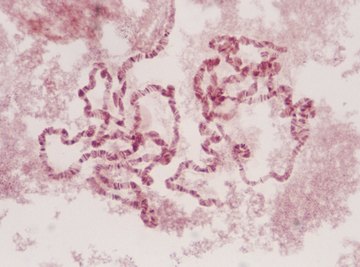
Deoxyribonucleic acid, more commonly referred to as DNA, is the molecule that's responsible for our genetic information. In fact, DNA is the source of hereditary material in almost all organisms on Earth.
Both prokaryotic cells and eukaryotic cells use DNA in order to code for their genes. DNA is found in almost all cells. DNA must be housed in certain areas of the cell in order to be processed, replicated and stored properly.
While both prokaryotic and eukaryotic cells have and use DNA as their genetic material, where DNA is found inside the cell is different for these two cell types. DNA location in prokaryotic cells can be defined by the nucleoid and plasmids. DNA location in eukaryotic cells can be defined by the nucleus and two organelles called the mitochondria and chloroplasts.
DNA Location in Eukaryotic Cells
Organisms within the domain Eukarya all have eukaryotic cells. This includes plants, animals, protists and fungi. Eukaryotic cells are defined as cells enclosed by a plasma membrane containing a nucleus and other membrane-bound organelles.
The nucleus. Eukaryotic cells are, in part, defined by the presence of a nucleus. The nucleus is where DNA is found inside the cell.
Where in the nucleus is DNA found? Well, the nucleus itself is surrounded by a membrane called the nuclear envelope. Within the nuclear envelope is where you'll find DNA along with enzymes and proteins necessary for DNA replication and transcription of DNA to mRNA as the first step in protein synthesis.
The DNA found within the nucleus isn't just the double-stranded DNA molecule. Because of just how much DNA each cell needs to store within the tiny nucleus, the long strands of DNA must be condensed. DNA is wrapped around proteins called histones, which allows the DNA to become compacted into a material known as chromatin. Without the packaging of DNA into chromatin, the DNA wouldn't fit within the nucleus.
Chromatin is what makes up the material of chromosomes. Each species has a certain number of chromosomes found within almost all somatic cells in their body. For example, humans have a total of 23 pairs of chromosomes in each cell, amounting to 46 total chromosomes; dogs have 39 pairs of chromosomes (for 78 total chromosomes) and spinach cells have six pairs of chromosomes (for 12 total chromosomes).
Mitochondrial and chloroplast DNA. Another place where DNA is found in the cells of eukaryotic organisms is within the mitochondria and chloroplasts.
Most eukaryotic cells contain mitochondria as these are what create the majority of the ATP cells need for energy. Plant cells (and some protist cells) contain chloroplasts to convert the sun's energy into usable chemical energy. Both of these organelles do contain some DNA.
It's believed that millions of years ago at the beginning life's history that both chloroplasts and mitochondria were once their own free-living cells. Scientists theorize that larger cells engulfed mitochondria and/or chloroplasts and incorporated them into their cell function and, thus, they became organelles.
This theory is called the endosymbiotic theory, and it explains why these organelles would have DNA: Since they were once free-living cells, they would've needed genetic material to function.
DNA Location in Prokaryotic Cells
Prokaryotic cells are simpler and less complex than eukaryotic cells. Prokaryotic organisms are within the domains Archaea and Bacteria. They're defined by the lack of a nucleus and a lack of membrane-bound organelles.
The nucleoid. Since prokaryotes lack a nucleus, that cannot be where DNA is found inside the cell. Instead, it is condensed into a region known as the nucleoid, a nucleus-like clump of condensed DNA in the middle of the cell.
It lacks a nuclear envelope, and there aren't multiple chromosomes. Instead, the DNA is coiled and condensed in a single strand/single clump in an irregular shape in the middle of the cell.
Plasmids. While plasmids can technically be found in cells of organisms in all three domains, they're most common in bacteria.
Plasmids are small, circular pieces of DNA that can enter and exit prokaryotic cells, transfer between cells in a process called conjugation and be replicated or transcribed separately from the chromosomal/nucleoid DNA. Plasmids are found within the cytoplasm of the cell.
References
- Addgene: Molecular Biology Reference: Origins of Molecular Genetics
- Biology LibreTexts: Bacterial Chromosomes in the Nucleoid
- Arizona State University: Ask a Biologist: Endosymbiotic Theory
- National Human Genome Research Institute: Chromosomes Fact Sheet
- U.S. National Library of Medicine: Genetics Home Reference: What Is a Chromosome?
About the Author
Elliot Walsh holds a B.S in Cell and Developmental Biology and a B.A in English Literature from the University of Rochester. He's worked in multiple academic research labs, at a pharmaceutical company, as a TA for chemistry, and as a tutor in STEM subjects. He's currently working full-time as a content writer and editor.
Photo Credits
Comstock Images/Comstock/Getty Images
